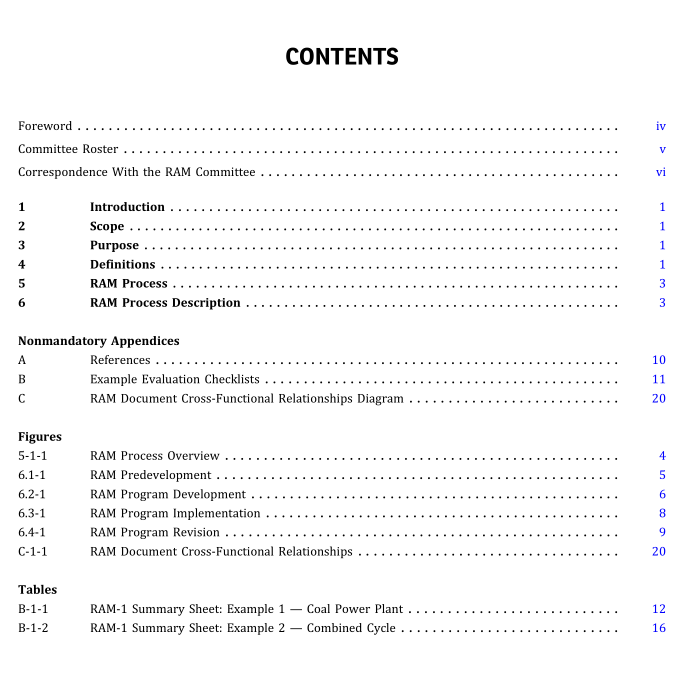ASME RAM-1:2020 pdf download Reliability, Availability, and Maintainability of Equipment and Systems in Power Plants
comprise equipment overhauls. Also called time-basedmaintenance.
maintainability:
(a) the ability ofan item to be retained in, or restored to,a specified condition when maintenance is performed bypersonnel having specified skill levels, using prescribedprocedures and resources, at each prescribed level ofmaintenance and repair.
(b) the ability of an item, under given conditions of use,to be retained in, or restored to, a state in which it canperform a required function, when maintenance isperformed under given conditions using stated proce-dures and resources.
maintenance: the aggregate of those functions required topreserve or restore safety, reliability, and availability ofplant structures, systems, or components. Maintenanceincludes not only activities traditionally associatedwith identifying or correcting actual or potential degradedconditions (e.g-. repair, monitoring, testing, inspectionexaminations),but also all supporting functions requiredfor the conduct of these activities. These include all activ-ities associated with the planning. scheduling. isolation,performance, restoration, post-maintenance testing,and return to service for surveillance and preventiveand corrective maintenance.These activities are consid-ered maintenance regardless of who performs them (e-g-.maintenance, operations, or engineering staff, or supple-mental personnel such as specialists and contractors).performance criteria: a specific quantitative value orthreshold established to provide a basis for determiningsatisfactory performance.Performance criteria are gener-ally based on the safety significance or economic successof a particular task,activity,or project. Performancecriteria are used to monitor the effectiveness of operationand maintenance of a plant or structure.For this Standard,the owner shall set performance criteria.
preventive maintenance: predictive, periodic,and plannedmaintenance actions, including calibrations and opera-tional tests, taken prior to structure, system, or compo-nent failure, to identify degradation and maintain thestructure., system, or component within the design oper-ating conditions by controlling degradation or failure.These shall comprise, at a minimum, the following:(a) condition monitoring
(by condition assessments (predictive activities)c) failure-finding tests
(d) hard-time (time-based) maintenance, includingoverhauls
(e) condition-based response (corrective mainte-nance)
reliability,availability, and maintainability(RAM):
(a) the process of addressing all the associated RAMconcepts and integrating them to meet the owner’s perfor-mance objectives
b) a set of requirements imposed on a plant, system, orcomponent to ensure that it
(1) will be ready for use when required
( 2y will successfully perform assigned design-intended functions
(3y can be maintained operationally over its speci-fied life
redundancy: a method of design where a duplicate struc-ture, system, or component is provided such that if onefails,the redundant structure, system, or component willoperate in its place to the extent that plant performance isnot affected. Diversity is a similar design concept thatachieves the same outcome by using alternative technicalmeans.
reliability: the probability ofan item to perform a requiredfunction under stated conditions for a specified period oftime, or the ability of an item to perform a required func-tion under given conditions for a given time interval.requirements: specific, quantifiable characteristics thatdefine the success of a project. These shall define plantfunction, plant life, plant output, and plant performance,e.g., plant efficiency, plant staffing. plant availability, plantreliability, plant maintainability, plant financials, andother characteristics that are important to the owner.This Standard requires the owner to provide specificplant requirements that will identify the success of theproject.
risk: the probability of a negative event occurring.
risk assessment: the method of assessing risk and quanti-fying the impact to public safety and/or plant perfor-mance. A risk assessment is done with the goal ofreducing the risk such that the plant can safely achievethe performance required by the owner. [See also risk.)system: a group of structures, components,instruments,and controls that together perform a specific function(s)within a plant. A system shall be capable of being definedby specific boundaries without overlap to establish clearownership.System definitions improve the manageabilityof a RAM program. A system may be open or closedregarding the fluids that it contains (e.g., air, steam,water, oil, or gas suchas Hz].Examples include condensatesystem, feedwater system, service air system, boilersystem, turbine system(s), control system, high-voltagesystem. The system definition can be either broad orvery detailed, as best serves the plant and RAMprogram. Systems will often be defined by piping and in-strumentation drawings (P&ID).Systems must be definedfor this Standard. Systems are typically identified by theplant’s designer as a part of the design process.
ASME RAM-1:2020 pdf download
